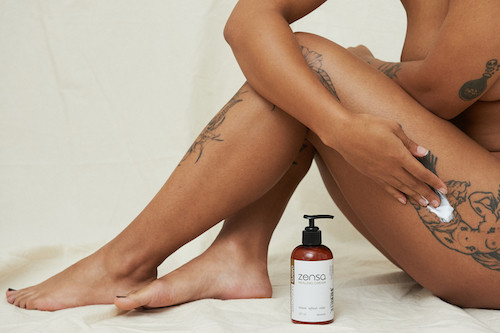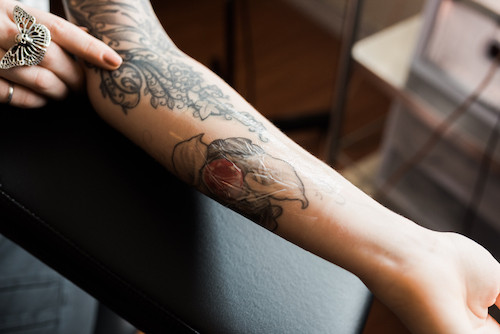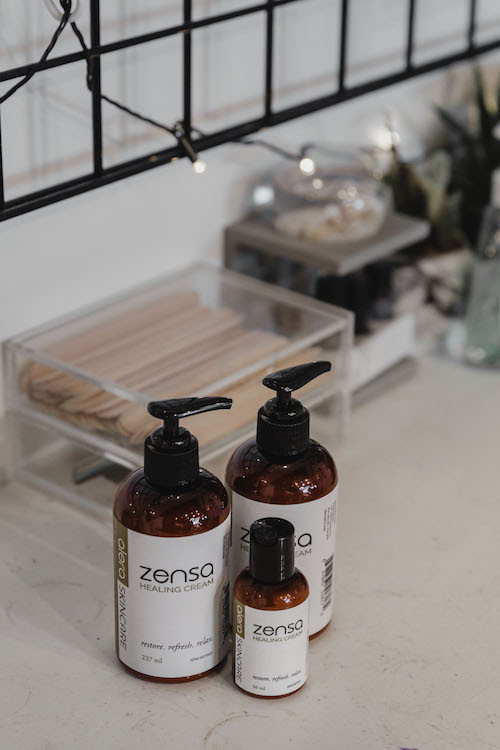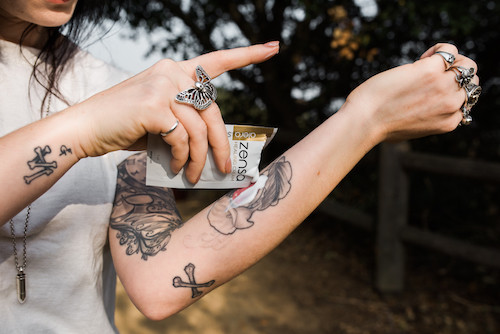Wearing a shirt after a tattoo is possible, but it requires careful consideration to ensure proper healing and prevent complications. This comprehensive guide from tattooat.com will explore the best practices for protecting your new tattoo while staying comfortable. We’ll cover fabric choices, potential risks, and essential aftercare tips to keep your ink looking vibrant. Learn how to navigate the first few days and weeks after getting inked, guaranteeing the art on your skin heals flawlessly. Dive in to discover how to keep your tattoo pristine with tattoo healing knowledge, expert artist insights, and optimal aftercare solutions.
1. Understanding the Importance of Proper Aftercare
Proper tattoo aftercare is paramount for preserving skin integrity and ensuring your tattoo heals correctly. A fresh tattoo, similar to an open wound, necessitates careful attention to prevent infection and ensure optimal healing. Tattooing, like minor medical procedures, involves needles and the potential for exposure to bodily fluids. The tattoo needle temporarily disrupts the skin’s natural barrier, triggering the body’s wound-healing response. While the skin begins to repair itself immediately, it takes approximately one week for protective scabs to form, shielding the area from germs, moisture, and irritants.
1.1 The Critical First 48 Hours
How you manage your new tattoo during the initial 48 hours is critical to its long-term health and appearance. During this initial phase, keeping your fresh ink clean, covered, and protected is crucial. Always adhere to your artist’s precise aftercare instructions, avoiding shortcuts or improvisations. The best aftercare starts even before you sit in the studio chair by researching and selecting a reputable artist in your area.
1.2 General Guidelines for Healing
There are general guidelines and best practices to follow throughout the tattoo healing stages. Every healing journey varies depending on the tattoo placement, size, and ink color. By following these general guidelines, you can ensure a smooth and successful healing process for your new tattoo.
 tattoo aftercare
tattoo aftercare
2. Can You Wear A Shirt After Getting A Tattoo?
Yes, wearing a shirt after getting a tattoo is generally acceptable, but several factors need consideration to ensure the healing process is not compromised. The primary concern is protecting the fresh tattoo from friction, bacteria, and other potential irritants that clothing can introduce. A clean, loose-fitting shirt made of breathable material like cotton is the best option to minimize these risks.
2.1 Initial Protection: Keeping It Covered
Immediately after getting a tattoo, the artist will apply a bandage or protective film. This initial covering serves as a barrier against environmental contaminants and should remain in place for the period recommended by your artist, usually between 3 and 24 hours. Once you remove the initial bandage, the decision to wear a shirt depends on the tattoo’s location and the type of clothing you plan to wear.
2.2 Balancing Protection and Air Exposure
While covering the tattoo can protect it, it’s also important to allow it to breathe to facilitate healing. Overly tight or non-breathable fabrics can trap moisture, creating an environment conducive to bacterial growth. This balance between protection and air exposure is crucial in the initial days following the tattooing session.
3. Choosing the Right Shirt Fabric
Selecting the right fabric for your shirt is a vital part of tattoo aftercare. Different materials offer varying levels of breathability, softness, and protection. Opting for fabrics that minimize friction and allow air circulation can significantly impact the healing process.
3.1 Cotton: The Go-To Choice
Cotton is the ideal choice due to its softness, breathability, and absorbent properties. It minimizes friction against the new tattoo and helps keep the area dry. According to a study by Portland State University’s Art Department in July 2023, cotton fabrics are the best option for new tattoos to allow airflow, which helps speed up the healing process.
3.2 Avoiding Synthetic Fabrics
Synthetic fabrics like nylon, polyester, and rayon should be avoided, especially in the initial healing stages. These materials tend to be less breathable, trapping moisture and increasing the risk of bacterial infections. Additionally, synthetic fabrics can sometimes be abrasive, causing unnecessary friction and irritation to the fresh tattoo.
3.3 Other Breathable Options
Other breathable options include linen, silk, and bamboo fabrics. Linen is lightweight and allows excellent airflow, while silk provides a smooth, gentle surface that reduces friction. Bamboo fabric is naturally antibacterial and moisture-wicking, making it another excellent choice.
4. Best Practices for Wearing a Shirt with a New Tattoo
To ensure a smooth and safe healing process, follow these best practices when wearing a shirt over a new tattoo. These guidelines will help minimize the risk of infection, irritation, and other complications.
4.1 Cleanliness is Key
Always wear a freshly washed shirt to minimize the risk of introducing bacteria to the new tattoo. Using a mild, fragrance-free detergent is also advisable to avoid potential skin irritations. Change your shirt at least once a day, or more frequently if you sweat excessively or the shirt becomes soiled.
4.2 Loose-Fitting is Better
Choose loose-fitting shirts that do not constrict or rub against the tattoo. Tight clothing can cause friction, leading to irritation and potentially disrupting the healing process. Loose clothing allows the tattoo to breathe and minimizes direct contact with the fabric.
4.3 Minimizing Friction
Friction is one of the primary concerns when wearing a shirt over a new tattoo. Minimize friction by selecting soft fabrics and avoiding activities that cause excessive movement or rubbing. If necessary, you can use a sterile bandage or non-adhesive pad to create a barrier between the tattoo and the shirt.
 tattoo wrapped
tattoo wrapped
5. What to Do if the Shirt Sticks to the Tattoo
Occasionally, a shirt might stick to a new tattoo, particularly if there is drainage or scabbing. This can be painful and potentially disrupt the healing process. Knowing how to handle this situation is essential to avoid further complications.
5.1 Do Not Rip It Off
If your shirt sticks to your tattoo, do not rip it off. Ripping the fabric can tear the skin and disrupt the scabs, increasing the risk of infection and scarring. Instead, take your time and gently loosen the fabric.
5.2 Wet the Fabric
Use clean, lukewarm water to wet the area where the shirt is stuck. The water will help loosen the fabric and allow you to gently peel it away from the tattoo. Avoid using hot water, as it can cause discomfort and inflammation.
5.3 Apply Antibacterial Ointment
After removing the fabric, clean the tattoo with a mild, antibacterial soap and apply a thin layer of antibacterial ointment. This will help prevent infection and promote healing. Cover the tattoo with a fresh, non-stick bandage if necessary.
6. Signs of Infection to Watch For
Being vigilant about potential signs of infection is a crucial part of tattoo aftercare. Early detection and treatment can prevent serious complications and ensure your tattoo heals properly.
6.1 Redness and Swelling
Some redness and swelling are normal in the first few days after getting a tattoo. However, if the redness spreads or the swelling intensifies, it could be a sign of infection. Monitor the area closely and consult a healthcare professional if you notice these symptoms.
6.2 Excessive Pain
While some discomfort is expected, excessive pain that worsens over time is a red flag. If the pain becomes severe or is accompanied by other symptoms like fever or chills, seek medical attention immediately.
6.3 Pus or Drainage
Pus or unusual drainage from the tattoo is a clear indication of infection. The discharge may be yellow, green, or have an unpleasant odor. Clean the area gently with antibacterial soap and consult a healthcare professional for appropriate treatment.
6.4 Fever or Chills
Systemic symptoms like fever or chills can indicate that the infection has spread beyond the local area. Seek immediate medical attention if you experience these symptoms along with signs of infection at the tattoo site.
7. Tattoo Aftercare Products
Using the right aftercare products can significantly enhance the healing process and protect your new tattoo. Selecting products specifically designed for tattoo aftercare is essential to avoid potential irritants and promote optimal healing.
7.1 Antibacterial Soaps
Choose a mild, fragrance-free antibacterial soap to clean the tattoo. Harsh soaps can strip the skin of its natural oils, leading to dryness and irritation. Gentle antibacterial soaps help remove bacteria without causing damage to the healing skin.
7.2 Moisturizers
Keeping the tattoo moisturized is crucial for preventing dryness, itching, and cracking. Opt for fragrance-free lotions or ointments specifically designed for tattoo aftercare. These products typically contain ingredients that promote healing and reduce inflammation.
7.3 Tattoo Balms
Tattoo balms offer a natural alternative to traditional lotions and ointments. These balms often contain ingredients like shea butter, coconut oil, and essential oils known for their moisturizing and healing properties.
7.4 Sunscreen
Protecting your tattoo from the sun is essential, especially after it has fully healed. UV rays can cause the ink to fade and damage the skin. Use a high-SPF, broad-spectrum sunscreen to protect your tattoo from sun exposure.
 tattoo cream
tattoo cream
8. Addressing Specific Tattoo Locations
The location of your tattoo can influence how you care for it, particularly when it comes to wearing clothing. Certain areas of the body are more prone to friction and require extra attention to ensure proper healing.
8.1 Upper Body Tattoos
For tattoos on the upper body, such as the arms, shoulders, or back, wearing a shirt is generally manageable. Choose loose-fitting, breathable fabrics to minimize friction and allow airflow. Avoid tight sleeves or restrictive clothing that can irritate the tattoo.
8.2 Lower Body Tattoos
Tattoos on the lower body, such as the legs or feet, may require more careful consideration when choosing clothing. Avoid tight pants, socks, or shoes that can rub against the tattoo. Opt for loose-fitting shorts or skirts and breathable footwear to allow the tattoo to heal properly.
8.3 Torso Tattoos
Torso tattoos, including those on the chest or abdomen, can be particularly challenging when it comes to clothing. Choose loose-fitting shirts or dresses that do not constrict the area. Avoid tight waistbands or belts that can rub against the tattoo.
9. What to Avoid During the First 48 Hours
Avoiding certain activities and substances during the first 48 hours after getting a tattoo is crucial for preventing complications and ensuring optimal healing.
9.1 Alcohol
Avoid consuming alcohol for at least 48-72 hours after getting a tattoo. Alcohol can thin the blood, leading to excessive bleeding and potentially affecting the healing process.
9.2 Excessive Sweating
Excessive sweating can create a moist environment that promotes bacterial growth. Avoid intense exercise or activities that cause you to sweat excessively during the initial healing stages.
9.3 Direct Sunlight
Direct sunlight can damage the skin and cause the tattoo ink to fade. Avoid prolonged sun exposure and always protect your tattoo with loose clothing or sunscreen once it has fully healed.
9.4 Harsh Soaps and Chemicals
Harsh soaps and skincare products containing fragrances or chemicals can irritate the tattoo and disrupt the healing process. Use mild, fragrance-free products specifically designed for tattoo aftercare.
 tattoo outside
tattoo outside
10. Long-Term Tattoo Care
Long-term tattoo care is essential for preserving the vibrancy and clarity of your ink. Following these guidelines can help keep your tattoo looking its best for years to come.
10.1 Hydration
Staying hydrated is essential for maintaining healthy skin and preventing the tattoo from drying out. Drink plenty of water throughout the day to keep your skin moisturized from the inside out.
10.2 Regular Moisturizing
Continue to moisturize your tattoo regularly, even after it has fully healed. This will help keep the skin supple and prevent the ink from fading.
10.3 Sun Protection
Protecting your tattoo from the sun is an ongoing process. Always apply sunscreen before spending time outdoors, even on cloudy days.
10.4 Avoid Harsh Chemicals
Avoid using harsh chemicals or abrasive products on your tattoo. These substances can damage the skin and cause the ink to fade.
11. Tattoo Healing Stages
Understanding the different stages of tattoo healing can help you better care for your new ink and recognize any potential issues.
11.1 Initial Stage (Days 1-3)
In the initial stage, the tattoo may be red, swollen, and tender. There may be some bleeding or drainage. Keep the area clean and protected, following your artist’s aftercare instructions.
11.2 Scabbing Stage (Days 3-14)
During the scabbing stage, scabs will form over the tattoo. It is essential not to pick or scratch at the scabs, as this can disrupt the healing process and lead to scarring or infection.
11.3 Peeling Stage (Days 7-21)
As the tattoo heals, the skin will begin to peel. This is a normal part of the process. Continue to moisturize the area and avoid picking at the peeling skin.
11.4 Fully Healed (4-6 Weeks)
A tattoo should be fully healed after around 4-6 weeks. The skin will appear smooth and the ink should be vibrant and clear. Continue to follow long-term care guidelines to keep your tattoo looking its best.
 tattoo healing
tattoo healing
12. When to Consult a Professional
Knowing when to seek professional advice is crucial for ensuring the health and longevity of your tattoo.
12.1 Signs of Infection
If you notice any signs of infection, such as excessive redness, swelling, pus, or fever, consult a healthcare professional immediately.
12.2 Allergic Reactions
Allergic reactions to tattoo ink are rare, but they can occur. If you experience itching, rash, or other signs of an allergic reaction, seek medical attention.
12.3 Scarring
If you notice excessive scarring or keloid formation, consult a dermatologist for appropriate treatment.
12.4 Fading or Patchiness
If your tattoo fades or becomes patchy despite proper aftercare, consult a tattoo artist for touch-up options.
13. Exploring Tattoo Designs on tattooat.com
For inspiration on your next tattoo design, explore the extensive collection at tattooat.com. Discover various themes, styles, and placements to find the perfect design that reflects your personality and preferences.
13.1 Diverse Themes and Styles
tattooat.com offers a wide range of tattoo designs, from traditional to modern and everything in between. Explore different themes, such as nature, animals, portraits, and abstract art, to find a design that resonates with you.
13.2 Artist Spotlights
Find talented tattoo artists and studios on tattooat.com. Our directory features profiles of skilled artists specializing in various styles.
13.3 Aftercare Guides and Tips
tattooat.com provides detailed guides and tips on tattoo aftercare, helping you keep your new ink looking vibrant and healthy. Learn about the best practices for cleaning, moisturizing, and protecting your tattoo during the healing process.
Address: 1825 SW Broadway, Portland, OR 97201, United States
Phone: +1 (503) 725-3000
Website: tattooat.com
14. Frequently Asked Questions (FAQs)
14.1 Can I rewrap my tattoo after the first night?
Yes, rewrapping your tattoo is permissible with medical-grade tattoo film; however, monitor for fluid buildup and skin cleanliness.
14.2 How long should I wait to shower after getting a tattoo?
Wait 3-4 hours before showering, using lukewarm water and clean towels.
14.3 What fabrics should I avoid when wearing a shirt after a tattoo?
Avoid synthetic fabrics such as nylon, polyester, or wool.
14.4 What are the best tattoo after-care practices?
Maintain cleanliness, hydrate internally, and moisturize externally while ensuring minimal friction.
14.5 What should I avoid during the first 48 hours after getting a tattoo?
Avoid moisture, harsh soaps, sunlight, and alcohol consumption.
14.6 How can I speed up my tattoo healing?
Ensure consistent aftercare: timely bandage removal, daily washing, moisturizing, and avoiding direct sunlight.
14.7 How often should I wash my tattoo?
Wash your tattoo 2-3 times daily, adjusting if using a continuous wrap.
14.8 What happens if I don’t moisturize a new tattoo?
Neglecting moisturizer can lead to cracking, irritation, infection, and premature fading.
14.9 Can you over moisturize your tattoo?
Yes, over-moisturizing can clog pores, heighten infection risks, and cause breakouts.
14.10 What are the different stages of tattoo healing?
The stages include the initial phase, scabbing, peeling, and full healing.
Properly wearing a shirt after getting a tattoo is a crucial aspect of aftercare, directly influencing how well your new ink heals and maintains its vibrancy. By carefully selecting breathable fabrics like cotton, ensuring a loose fit to minimize friction, and diligently following hygiene practices, you can protect your tattoo while staying comfortable. Remember, cleanliness is paramount—always opt for freshly washed shirts and avoid synthetic materials that can trap moisture and bacteria. Stay vigilant for signs of infection, such as increased redness, swelling, or unusual discharge, and promptly consult a professional if any concerns arise. Tattooat.com is your go-to source for inspiration, artist connections, and expert advice to ensure a smooth and successful tattoo journey. Explore tattooat.com today to discover a wealth of designs, find the perfect artist, and access comprehensive aftercare guides that will help you cherish your body art for years to come.

